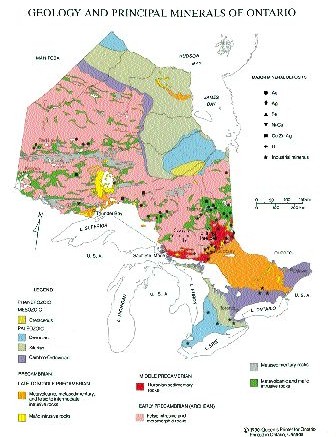On geological maps of northeastern Ontario, the Kenogamissi batholith sits like a giant blister on the heel of the Abitibi greenstone belt, interrupting the northeast-southwest flow of the prolific belt and creating a physical and psychological barrier to exploration. Why venture to the other side of the intrusion when the richest ore has always been found in Abitibi proper?
Precisely because the other side — namely the Swayze greenstone belt to the west and, to a lesser extent, the Shining Tree belt to the south — is relatively underexplored, according to several small companies returning to these areas to take advantage of the resurgence in the gold price and easy access to flow-through financing.
“When people start going back to look at Swayze, then you know it’s good times in the industry,” says Brian Atkinson, regional resident geologist for the Timmins district. He considers the carbonate-altered mafic volcanics of the Swayze belt to be prime hunting ground for gold deposits similar to those found in the Timmins camp.
Geologists have long postulated that the Swayze belt may be the western extension of the Abitibi, with the same potential for giant ore deposits. But the theory has never been proven, and Swayze, though dotted with mineral occurrences, has yet to yield a significant deposit. The Shining Tree belt has a similar history of small-fry discoveries.
But several companies, including
“We felt as if we had to find something that was a little contrarian, but also fish where the fish are,” says Kirk McKinnon, president and chief executive officer of VenCan. “I think we’re the first movers in a new look at the western Abitibi.”
Pretty daring of McKinnon, calling it the western Abitibi. But then VenCan’s entire business plan rests on the premise that Swayze is not an independent belt at all but rather an extension of the Abitibi that was merely cut off by the batholith intrusion.
The two belts do have similar stratigraphy and tectonic history, according to a 2003 open-file report by OGS geologists Jens Becker and Keith Benn that analyzes extensive new structural, geochemical, geophysical and geochronological evidence. The VenCan properties themselves are underlain by units now considered to be time-stratigraphic equivalents of the prolific portion of the Abitibi.
VenCan plans to focus its exploration efforts on banded iron formation and shear-hosted gold deposits. Other companies looking for gold on the belt include:
–
–
–
–
–
From the Swayze belt, a gentle curve around the bottom side of the Kenogamissi batholith leads to the southern extension of the Abitibi belt, or the Shining Tree area, where another quiet gold rush is taking place.
“Even though the geology in the Shining Tree area is similar to the Timmins and Kirkland Lake areas, it was never subjected to the same intensity of exploration,” says Gerhard Meyer, resident geologist for the Kirkland Lake area. “Recent results clearly demonstrate potential for the area.”
The latest rush is centred around
Having outlined this low-grade, potentially open-pit-minable resource at Juby, Temex is now concentrating on finding higher-grade mineralization on the nearby Jumping Moose and Latchford project areas. The mineralized material could be mixed with the Juby material to create a viable gold operation, says President and CEO Brian Groves.
The exploration program follows the discovery in late 2003 of a Proterozoic, mafic intrusive boulder near Latchford, Ont., which returned more than 6,000 grams gold per tonne in vein material similar to high-grade silver veins found in the Cobalt silver camp. Temex staked more than 240 sq. km around the car-sized boulder and called the land package the Latchford project.
A subsequent, 16-hole drill program collared on several coincident soil geochemical, induced-polarization, and magnetic anomalies failed to find the source of the mineralization. However, a more recent trenching program at the Merico Ethel property, part of the project area, returned up to 5.99 grams gold per tonne and 6.33% copper over 0.5 metre from channel samples in narrow, polymetallic, steeply dipping quartz-carbonate veins and vein-shear systems hosted by diabase.
“The game plan is to find gold-enriched veins similar to the Cobalt veins,” says Ian Campbell, vice-president of exploration. (Diabase sills are an important host to Proterozoic silver veins in the Cobalt camp, which produced about 450 million oz. silver in the previous century.)
Temex is also working with
Nearby,
Closer to Matachewan,
East of Matachewan,
.
— The author is a Toronto-based geologist and freelance writer specializing in mining and the environment. She is principal of GeoPen Communications, www.geopen.com.


Be the first to comment on "Swayze, Shining Tree recapture ray of limelight"